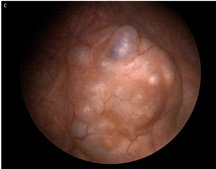膀胱輸卵管內膜異位-罕見案例報告
李明儒12、溫聖辰2
1高雄市立小港醫院 泌尿部;2高雄醫學大學附設醫院 泌尿部
An Unusual Presentation of a Bladder endosalpingiosis
Ming Ru Lee12, Sheng-Chen Wen2
1Department of Urology, Kaohsiung Municipal Siaogang Hospital, Kaohsiung, Taiwan;
2Department of Urology, Kaohsiung Medical University Hospital, Kaohsiung Medical University,
Kaohsiung, Taiwan
Background: Bladder endosalpingiosis are rare anomalies revealed as the presence of endometrium at ectopic sites not in the uterus, but in the bladder. The objective of the case presentation is to provide the review of the rare bladder endosalpingiosis in the clinical characteristic, differential diagnosis, pathogenesis, histological features and treatment.
Case presentation:A 55-year-old woman presented to the urology outpatient clinic with suprapubic pain for 4 months. Other symptoms included dysuria, intermittent hematuria and urinary frequency. Her surgical history included a cesarean section performed 24 years ago. During physical examination, pelvic tenderness was mentioned during palpation. Ultrasonography showed a bladder tumor. Pelvis computed tomography with contrast suspected a bladder malignancy mass. Magnetic resonance imaging was arranged and a bladder non-epithelial neoplasm was noted. Cystoscopy showed an irregular edematous multiloculated lesion at the right side of the bladder. Differential diagnosis included bladder cyst, bladder urothelial carcinoma, metastatic carcinoma, bladder cystadenoma, and bladder abscess. Biopsy was done however the result showed non-diagnostic. Partial cystectomy was performed afterward. Histopathological analysis of the resected mass revealed ectopic columnar epithelium and secretory mucous cells. No endometrial stroma tissue was noted. The feather confirmed the diagnosis of bladder endosalpingiosis.
Conclusion: Bladder endosalpingiosis is lesion revealed tubular glands covered by ciliated epithelium with challenging diagnosis. It is generally believed the formation is that heterotopic endometrial tissue might originate from both the uterine and tubal mucosa but fail to imply embryonic origin. Bladder endosalpingiosis was rare and has the increasing risk of developing malignancies. The diagnosis is clinical with histological confirmation. We believe it is important for clinicians not only to recognize, but also to differentiate diagnosis with other lesions. With the chance of recurrence, surgical removal is indicated. And follow-up is also needed because of a tendency of the lesion to recur.
 .
. 
